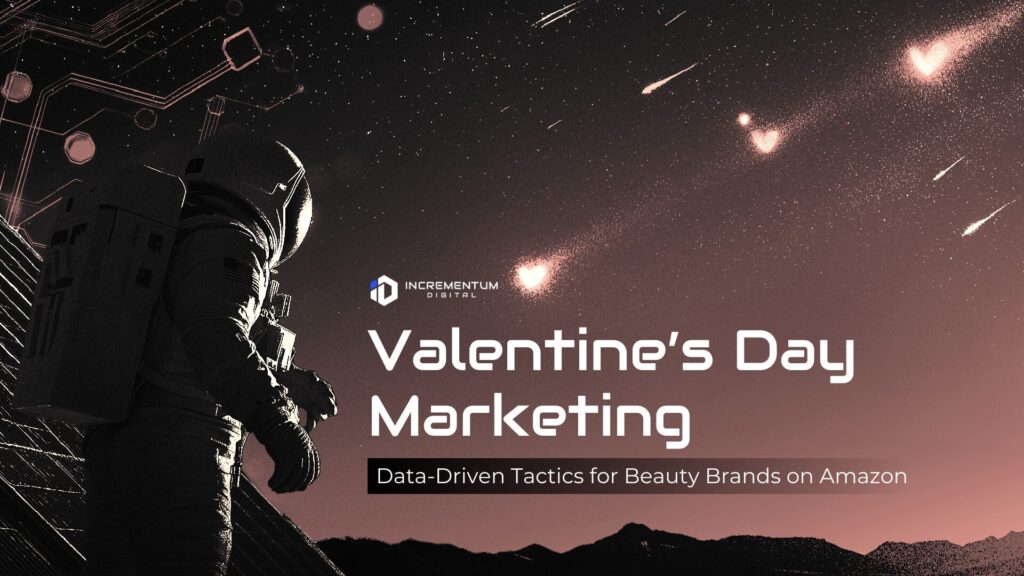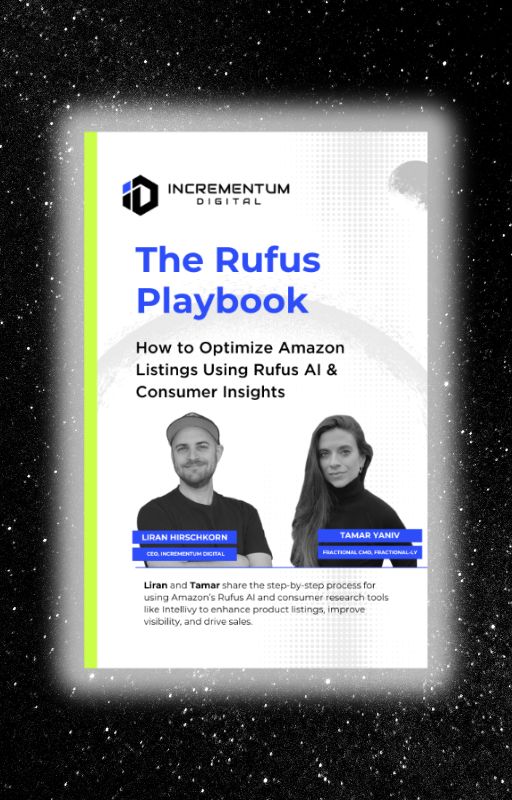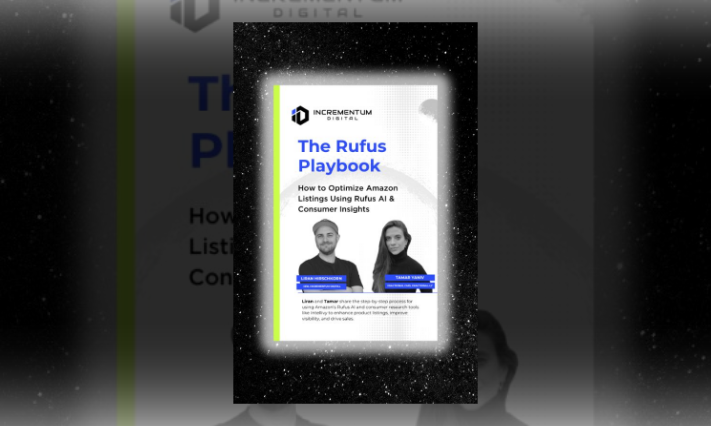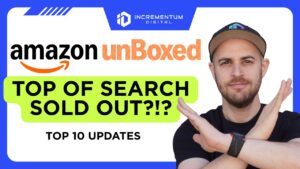Amazon Advertising
Winning Valentine’s Day 2025: How Beauty Brands Can Maximize Sales on Amazon

Valentine’s Day has evolved from a celebration of romance to an all-out gifting frenzy. It’s no longer just about partners, it’s about best friends, moms, siblings, and even self-love splurges. From Galentine’s gatherings to luxury skincare gifts for mom, shoppers are looking for the perfect way to show they care. And with beauty products ranking among the top Valentine’s Day gifts, brands that tap into this trend early can turn love into serious sales. With U.S. Valentine’s Day spending projected to hit $27.5 billion in 2025—the highest on record and a $1.6 billion increase from 2023—the opportunity for brands has never been bigger.

Learn How to Make Listings That Convert in 2025!
Read our step-by-step guide on how to optimize your listings using Rufus AI insights. Sign up for our newsletter and get your copy for free!
Show me howBeauty products remain a top choice for Valentine’s Day gifts. According to Amazon Ads’ 2024 data, skincare, hair care, and luxury beauty ranked among the top 10 most gifted items on Amazon. Shoppers start browsing in January, with sales peaking in the first 10 days of February, making it critical for brands to launch campaigns early and strategically.
But with thousands of beauty brands competing for the same audience, standing out requires more than just running ads; you need a data-driven strategy. Instead of guessing which keywords will drive conversions, dig into real shopper data from previous years to see exactly what worked. Here’s how you can do the same.
How to Find Winning Valentine’s Day Keywords on Amazon
Every year, shoppers flock to Amazon looking for the perfect beauty gift, whether it’s luxury skincare, fragrances, or spa sets. The trick is knowing which search terms are actually converting so you can bid strategically and avoid wasting ad spend.
Amazon Brand Analytics gives you exactly that insight. Mansour shared a strategic tip for uncovering last year’s top-performing Valentine’s Day keywords so you can optimize for this year.
Here’s how to do it:
- Go to Amazon Brand Analytics → Top Search Terms. This is where Amazon reveals what shoppers are actually searching for.
- Type “Valentine” in the search bar. This will filter results to show all Valentine’s-related search trends.
- Select the most recent February data. This gives you a clear snapshot of last year’s biggest keywords—which are likely to perform well again this year.
- Analyze top-performing search terms and trends. Look for patterns: Are shoppers searching for “luxury skincare gifts”? Are gift sets trending more than individual beauty products? Spot these trends and adjust your campaigns accordingly.
Why does this matter? Because bidding smart beats bidding big. Instead of throwing money at high-competition keywords like “Valentine’s Day gifts”, find niche, high-intent searches that actually convert. If last year’s data shows fragrances and skincare bundles were bestsellers, focus your ads on those categories. By using this data-driven approach, beauty brands can reach the right shoppers, maximize ad efficiency, and drive more sales—all without overspending.
When to Start Advertising for Valentine’s Day
Shoppers don’t wait until February 14 to start searching for gifts—browsing begins in early January and peaks in the first 10 days of February. To maximize sales, beauty brands should align their ad strategy with how and when consumers are shopping.
Early January: Build Awareness
At the start of the year, gift shoppers are browsing but haven’t made their final decisions yet. This is the time to introduce your brand and products with high-visibility ad formats that build awareness.
Amazon DSP and Streaming TV ads can help reach shoppers engaging with beauty-related content, while Sponsored Brands campaigns allow brands to showcase curated gift sets and premium beauty products in search results.
Sponsored Display with audience targeting is also effective for reaching shoppers already searching for related categories like fragrances, skincare, and self-care gifts. This early awareness phase ensures that when shoppers are ready to buy, your brand is already top of mind.
First 10 Days of February: Capture Conversions
As Valentine’s Day gets closer, shoppers shift from browsing to buying, making this the time to focus on conversion-driven campaigns.
Sponsored Products campaigns help brands appear at the top of search results for high-intent shoppers actively looking for beauty gifts.
Sponsored Display with product targeting ensures visibility on competitor product pages and related items, giving brands an opportunity to win over undecided shoppers.
Retargeting campaigns are especially effective during this period, re-engaging consumers who visited product pages but didn’t complete a purchase.
Post-Valentine’s Day: Retarget and Build Loyalty
The shopping cycle doesn’t end on February 14. Data shows that more than 70% of beauty shoppers make a repeat purchase within three months, meaning Valentine’s Day buyers can be converted into long-term customers. Sponsored Display remarketing allows brands to re-engage customers who previously purchased beauty products, introducing them to new offerings and complementary items. Exclusive loyalty promotions can encourage repeat purchases, especially leading up to Mother’s Day—another high-spending occasion for beauty brands. Cross-selling campaigns featuring skincare, fragrances, and spa products can also help brands maintain momentum beyond the holiday.
High-Performing Valentine’s Day Ad Strategies for Beauty Brands
With Valentine’s Day spending at an all-time high, beauty brands need to target the right consumers, use the best ad formats, and craft compelling messaging to drive sales. Here’s how to build a winning ad strategy.
Target the Right Consumers
Not all Valentine’s Day shoppers are buying for a significant other. Beauty products appeal to a range of consumers, and understanding these segments can help brands refine their advertising approach:
- Gift Givers: Spouses, partners, and friends searching for meaningful presents. These shoppers look for luxury beauty sets, fragrances, and skincare bundles that feel special and thoughtful.
- Self-Gifters: Many shoppers use Valentine’s Day as an excuse to treat themselves. Ads that highlight self-care, relaxation, and indulgence can appeal to this audience.
- Luxury Shoppers: High-end skincare, perfumes, and spa treatments remain top-selling categories. These buyers are willing to spend more on premium products, so emphasizing exclusivity and quality is key.
Advertising Formats to Use
To maximize reach and conversions, beauty brands should use a multi-channel advertising approach that engages shoppers at every stage of their buying journey.
- Sponsored Brands & Sponsored Display: Increase visibility in Amazon search results by featuring gift-worthy beauty products with eye-catching creative.
- Amazon DSP & Streaming TV Ads: Reach off-Amazon audiences who are searching for beauty gifts, watching Valentine’s-related content, or engaging with similar product categories.
- Sponsored Products & Retargeting Ads: Capture high-intent shoppers actively searching for beauty gifts and re-engage those who viewed products but didn’t purchase.
Ad Messaging and Creative Ideas
Great ad copy and visuals make all the difference. To connect with different types of Valentine’s Day beauty shoppers, messaging should feel personal, relevant, and emotionally compelling. Here are tailored ad slogans that align with each major demographic.
For Gift Givers (Spouses, Partners, and Friends)
- “A gift as beautiful as they are.” (Highlights thoughtfulness and personal connection.)
- “Luxury beauty, the perfect way to say ‘I love you.’” (Elevates the product as an expression of love.)
- “Because they deserve the very best.” (Speaks to premium beauty buyers looking for high-quality gifts.)
- “Unwrap love, one beauty gift at a time.” (Creates a gifting experience.)
For Self-Gifters (Treating Themselves to Beauty Products)
- “Indulge in a little self-love.” (Perfect for skincare, spa, and relaxation-focused products.)
- “This Valentine’s Day, love yourself first.” (Encourages self-care as a priority.)
- “Who says you need a Valentine to glow?” (Playful and empowering for solo shoppers.)
- “Because you’re the love of your own life.” (A confident, feel-good message.)
For Luxury Beauty Shoppers (High-End Skincare, Fragrances, Spa Products)
- “Elevate every moment with luxury beauty.” (Speaks to indulgence and quality.)
- “Opulence meets romance.” (Ideal for premium skincare and fragrance ads.)
- “Luxury that loves you back.” (Ties self-care and high-end beauty together.)
- “Timeless beauty, for a timeless love.” (Perfect for classic, sophisticated beauty products.)
For Galentine’s & Friendship Gifting (Best Friends, Sisters, Coworkers)
- “Beauty is better when shared.” (Encourages gifting beauty products to friends.)
- “The perfect gift for your favorite person.” (Personal and versatile.)
- “Because besties deserve the best.” (Warm and playful.)
- “Celebrate friendship with a little glow.” (Great for skincare and makeup brands.)
For Last-Minute Shoppers (Urgency-Driven Messaging for Fast Shipping)
- “The perfect Valentine’s Day gift—just in time.” (Ideal for Amazon’s fast-shipping capabilities.)
- “Last-minute? We’ve got you covered.” (Direct and reassuring.)
- “Luxury beauty, no waiting required.” (Creates urgency while reinforcing high-end quality.)
- “Fast, thoughtful, and unforgettable.” (Speaks to convenience and impact.)
By tailoring messaging to specific shopper motivations, beauty brands can increase ad relevance, engagement, and conversions during the Valentine’s Day shopping season.
Gift Set Promotions & Bundles: Bundling best-selling beauty products into gift sets makes shopping easier and encourages higher order values. Brands should promote limited-time Valentine’s Day bundles with messaging that highlights exclusivity and convenience.
How to Turn Valentine’s Day Shoppers into Repeat Customers
It is in every beauty brand’s goal to make Valentine’s Day an entry point for long-term customer relationships. Shoppers who buy beauty products as gifts often return to buy for themselves, especially if they had a positive purchasing experience. And Amazon’s data backs this up: over 70% of beauty shoppers repurchase within three months.
This creates a prime opportunity for remarketing and retention strategies that extend far beyond February 14. The goal is to convert seasonal buyers into loyal, repeat customers who return for self-care, gifting occasions, and everyday beauty essentials. Here’s how brands can capitalize on this momentum:
Sponsored Display Remarketing: Stay Top of Mind
Behavioral psychology tells us that familiarity breeds preference: shoppers are more likely to repurchase from a brand they recognize. Sponsored Display remarketing ensures that Valentine’s Day customers continue seeing your products even after the holiday rush is over. By targeting past buyers with ads showcasing related beauty products or limited-time offers, brands can encourage repeat purchases and build brand loyalty.
Exclusive Loyalty Offers: Drive Repeat Purchases
Consumers love incentives, especially when they feel exclusive. Offering post-Valentine’s promotions—such as discounts, early access to new collections, or loyalty perks—can entice first-time buyers to return. This strategy works exceptionally well leading into Mother’s Day, another major gifting event where beauty products are top sellers. Aligning promotions with key shopping occasions extends the lifecycle of seasonal customers.
Cross-Selling Beauty Categories: Expand Purchase Behavior
The way shoppers interact with beauty products is largely habit-driven. So if someone buys skincare, they’re likely to explore complementary categories like fragrances, hair care, or salon-quality treatments. Brands can use Sponsored Display and Sponsored Products ads to cross-promote related beauty categories, encouraging customers to try additional products based on their Valentine’s Day purchase history.
For beauty brands, Valentine’s Day is a great opportunity to capture new customers and turn them into repeat buyers. A strategic approach that leverages remarketing, loyalty incentives, and cross-category promotions ensures that the customers gained in February keep coming back well into the year.
Maximize Valentine’s Day Sales with a Data-Driven Approach
The key to success isn’t just running ads, it’s running the right ads at the right time. By using Amazon search trends, brands can focus on the keywords and products shoppers are actively searching for, making every ad dollar more effective.
Starting campaigns early helps capture browsing shoppers in January, while conversion-focused ads in early February ensure your products stay visible when buying urgency is highest. After the holiday, remarketing can turn seasonal buyers into repeat customers, setting the stage for future sales events like Mother’s Day and self-care promotions.
If you’re looking for ways to refine your Amazon ad strategy and maximize results, we’re here to help. Get a free brand audit today and see how you can make the most of your Valentine’s Day campaigns.
LET’S DISCOVER WHAT’S POSSIBLE FOR YOUR BRAND
We’re here to listen and uncover opportunities tailored to your unique goals.
Fill out the form to get started, and you’ll walk away with real insights and actionable recommendations—whether we work together or not.
- HANDS-ON LEADERSHIP
- AWARD-WINNING PARTNERSHIPS
- CUSTOM-BUILT SOLUTIONS




